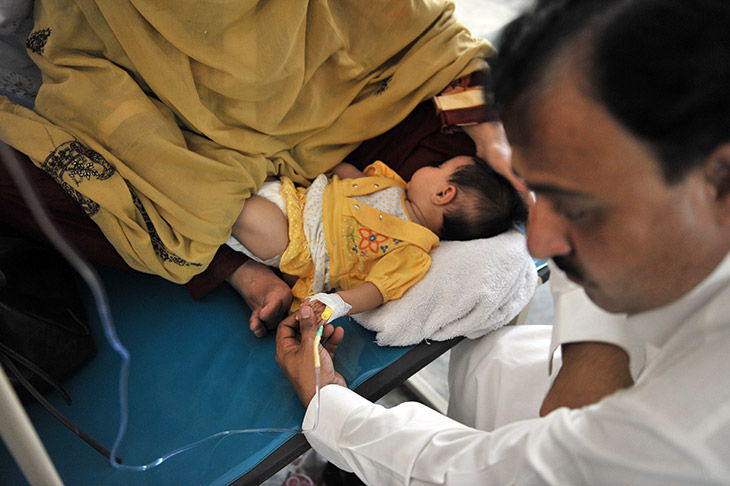Healthcare facilities in Pakistan: A crisis in numbers
Access to healthcare is a problem that seems to make itself obvious every few weeks in Pakistan, says Luavut Zahid, who has commissioned this blog. People in urban centres often complain of the quality of healthcare and facilities available, and the situation in rural areas is much, much worse. It is important to highlight how the lack of facilities in rural areas does not just cause great panic and grief for people within those areas, but also, in effect, ensures that whatever facilities are available for urban centres, they are used in the most inefficient ways possible.
Healthcare in Pakistan exists in a perpetual state of emergency. While urban centres have scattered facilities, the rural structure is almost non-existent, writes Ali Sajid Imami.

Facilities at the rural level, comprising Rural Healthcare Centres (RHCs) and Basic Healthcare Units (BHUs) are not equitably distributed and, where they are, they lack both proper equipment and the manpower to keep them working in the best way possible.
I spoke to Dr Ismail, who is the Assistant Medical Superintendent of a governmental hospital in Multan, Punjab, about the issue.
“We are now at 192 per cent capacity and most of the patients are from the rural area surrounding the city,” he told me.
“We are the major hub for the entire division, and the biggest tertiary care hospital, yet more than 70 per cent of cases we cater to here could have been dealt with at primary and secondary care levels,” he added.
He shed some light on the situation in terms of primary and secondary care facilities: “As far equipment and facilities go, all the basic necessities are there. We have adequate equipment for surgery available even in the most thinly provisioned THQs. The problem is that the staff won’t show up and the doctors would rather refer the patients to other central hospitals rather than do the work themselves.”
Things are not good at the BHUs either: they are underfunded, ill-equipped and most importantly, understaffed. Hamza Khokhar, a Medical Officer in charge of a BHU explained that the problem is fairly deep rooted.
“The BHU that I am working on has not had a doctor working there the past four years. Officially, there are doctors assigned there and everything is in order, but no one actually shows up. This contributes to the dismissive attitudes people have towards doctors working in BHUs.”
When asked about the availability of facilities, he said: “We are actually very well equipped for a primary care centre. However, if the doctor is there but other staff are not, then I cannot manage everything here as well. We have to refer to secondary or tertiary care centres instead, and that both wastes time and money.”
To look into the number of rural area people who are actually admitted into these wards I spoke to Asif, a post graduate registrar in a tertiary care hospital. “Ninety per cent of the patients admitted to our wards are from rural areas and at least half of those are ones who could be treated at secondary level care centres,” he said.

A doctor checks children in Muzaffargah, Multan, Pakistan. locality, on AUGUST 30, 2010 in Multan. Bottlenecks often occur as patients try to present themselves at higher levels within the healthcare sytem
(images: Shutterstock / Thomas Koch)
Asif further outlined that in secondary care centres, like Tehsil Headquarter Hospitals and District Headquarter hospitals, there are enough facilities to take care of most, if not all these cases, but they keep referring cases to the tertiary care hospital, citing the unavailability of resources. This in effect creates a bottleneck.
Access to healthcare facilities is also not very good. For instance, in the Multan district, with almost half the population in rural areas, there are only 90 healthcare centres available on a basic level for a population of over two million people.
The dispensaries and the pharmacies in such facilities are often under-equipped and understaffed. This contributes to the mistrust people have of the primary health-care system and they opt to go directly to the tertiary care hospitals, overloading their already considerably strained resources.
The lack of a formal referral system is also a contributory factor. Under normal circumstances, BHUs will is the first point of reception for all patients, referring patients upwards as appropriate; whereas the higher levels within the healthcare system will only accept referrals and not ‘walk-in’ patients.
The lack of such a structure makes people think that they would be treated better if they were to go directly to the higher rungs and bypass the normal process.
What the country desperately needs right now is a more structured emphasis on healthcare. If a province like Punjab, which is the most developed, cannot handle its ill people, then who can?
Ali Sajid Imami is a writer based in Multan, Pakistan, who has a deep interest in social issues including education and access to healthcare. He tweets @doctor_no
Luavut Zahid, 02/07/2015